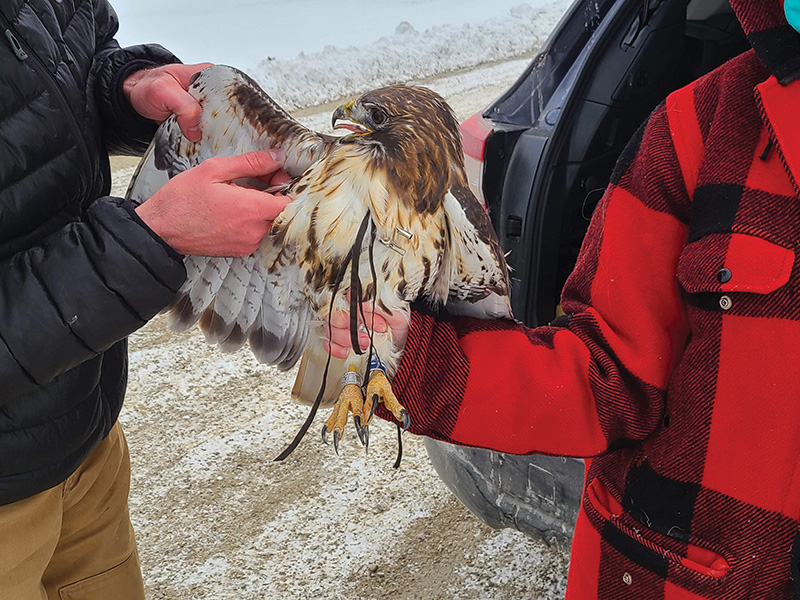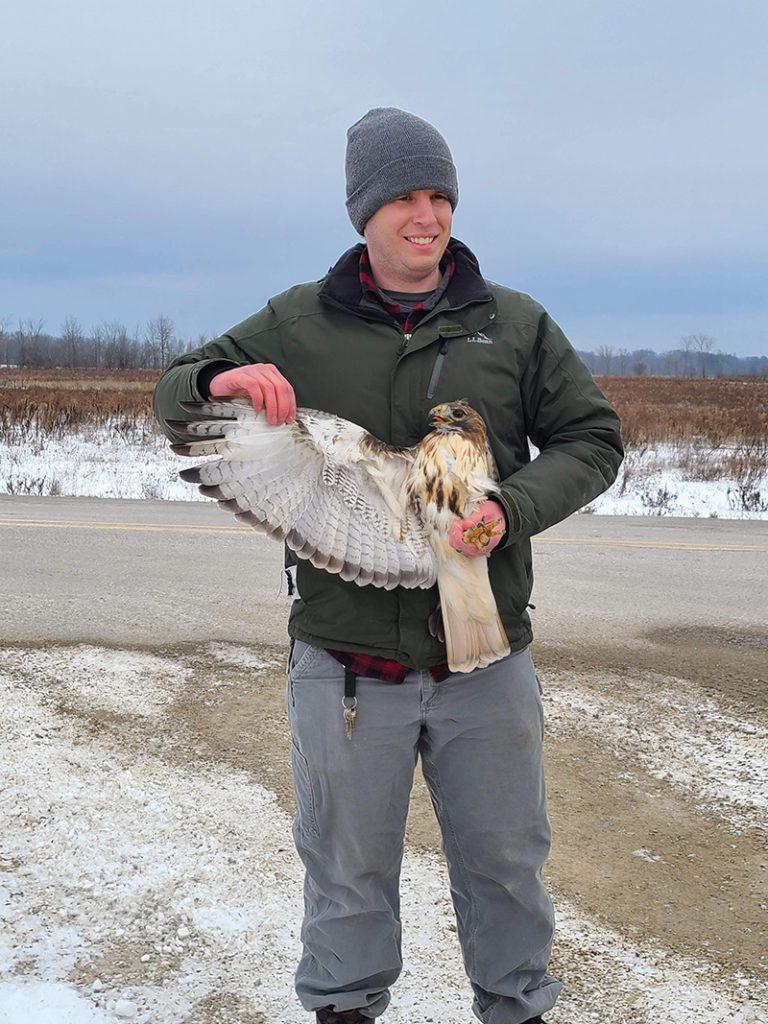
Soaring with Red-Tailed Hawks
 “They use their feet to catch and crush and kill their prey, and that’s the part that we have to worry about when we’re handling them.”
“They use their feet to catch and crush and kill their prey, and that’s the part that we have to worry about when we’re handling them.”
That’s Jim Armbruster, field research coordinator for the Vermont Institute of Natural Science, or VINS, in Quechee, Vermont, talking about the immense gripping strength of a red-tailed hawk’s talons.
Armbruster said the muscles and tendons in the red-tail’s legs act like ratchet straps, allowing the raptor to tighten and hold that grip on captured prey, without them thinking about it.
“We’ve learned,” he adds, “that if the hawk grabs on to something that they’re not supposed to, like a towel—or a finger, God forbid—you can pull their legs out straight and release that tension.”
When I caught up with Armbruster, he and his colleagues from VINS were studying Vermont red-tails and their migratory habits. “We do know red-tails are partial migrants,” Armbruster said, adding, “Some will migrate, and some will stay put throughout the winter.” But they wanted to find out where these hawks are going, when they’re not in the Green Mountain state.
To begin their study, they captured several red-tails alongside farm roads with a Bal Chatri trap, a centuries-old device used by falconers. “Basically, it’s a metal cage with an inner cage that a mouse goes into, and along the top are little nooses made of nylon fishing line,” Armbruster explained. “The red-tails swoop down and land on the trap and stomp on it with their feet, and as they’re stomping, the nooses tighten around their feet, and that’s how we (harmlessly) trap them.”
After banding and releasing the birds, however, the results were disappointing. “You put a band on the bird, release it, and you never hear from it again, which is common,” Armbruster said.
Then they collaborated with Bryce Robinson, a researcher from the Cornell Lab of Ornithology, who, with other researchers, is working on a nation-wide Red-Tailed Hawk Project, and this proved more productive. They strapped tiny GPS devices on the backs of two red-tails, enabling them to closely track and follow the birds.
 “It’s hard to make any conclusions, or say for certain what we found, because we only had two birds [to work with].” But they discovered one red-tail stayed in Vermont year-round, while the other flew deep into Northern Canada.
“It’s hard to make any conclusions, or say for certain what we found, because we only had two birds [to work with].” But they discovered one red-tail stayed in Vermont year-round, while the other flew deep into Northern Canada.
“We trapped that bird in the middle of Middlebury College’s campus, which is a pretty urban area,” Armbruster said. Then the hawk flew around Addison County, a large agricultural area on the west side of Vermont, sailed into New York, and then migrated far into rural Canada, before returning to Vermont.
“Unfortunately, we lost contact with him a year ago,” Armbruster said. “That happens sometimes, where the transmitter doesn’t work, or the bird dies.”
Armbruster admits he’s liked birds all his life. He grew up near Worcester, Massachusetts, and graduated from the University of Vermont with a degree in wildlife biology. “While I was there, I really started focusing on birds.”
“To learn more about red-tailed hawks,” I asked Armbruster, “what’s the average life expectancy of these beautiful birds of prey?”
The bigger the raptor, the longer they live, he said. A bird that size, in the wild, weighing two pounds, with a wingspan of almost four feet, might live ten to fifteen years. “I think the oldest recorded red-tail in the wild lived to be nineteen years old, but that’s an exception,” Armbruster said, adding a startling statistic that 70–80 percent of red-tailed hawks don’t make it past their first year.
“Why?”
“It’s hard being a young raptor. They are learning how to fly, how to hunt and avoid people. And if they survive that first year, they have a pretty good chance of getting to that full life expectancy,” Armbruster said.
“Finally,” I asked, “why are red-tails important?”
For red-tails and other raptors, it’s pest control, Armbruster said. They live in agricultural fields and take care of the rodent population. “Without that predator, we’d be up to our ankles in mice and rats.”
Bill Hobbs is a contributing writer and columnist for Estuary magazine. He lives in Stonington, CT, and can be reached for comments at whobbs246@gmail.com.

